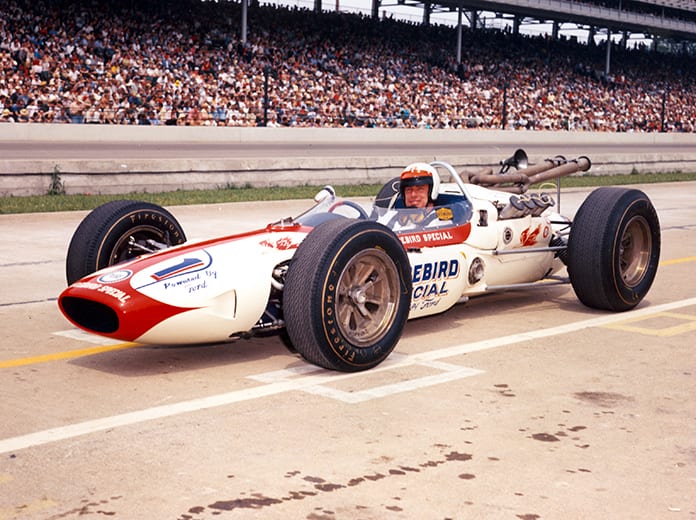It was May 30, 1964, and a crowd of more than 300,000 at Indianapolis Motor Speedway sat silent.
A fiery, race-stopping accident had claimed the life of crowd favorite Eddie Sachs and left popular newcomer Dave MacDonald horribly burned. He died a few hours later.
The green flag didn’t wave again for nearly two hours with the crowd still subdued. Then, suddenly, the throng collectively sprang to its feet. Finally, there was something to cheer about.
Young Bobby Marshman, from Pottstown, Pa., in his red-white-and-blue Pure Firebird Special, a Jack Beckley re-engineered, year-old Lotus/Ford, blasted past a startled Jim Clark and into the lead.
This bold move jerked the crowd out of its pall. Clark, in his English “funny car,” funded by Ford, was expected to dominate. It was the American, however, who was rewriting Indianapolis history. At laps 10, 20 and 30, Marshman obliterated the old records by a startling 10 mph.
At 35 laps he led Clark by 23 seconds. Maneuvering around the slower car of rookie Johnny White, Marshman dropped low — too low. His Lotus bottomed out, ripping out the oil plug. By lap 40 his Ford engine was cooked.
As the slender Marshman wiggled from the car’s tight confines, it surprised many to see a smile cross his handsome, rugged face. He was smiling because he knew he could run with the best. He understood that he could win Indianapolis. It was, most agreed, only a matter of time.
Destiny decided differently, however. Before the year ended, the talented, promising, hero was gone. Killed in the same car that carried him into Indy 500 lore.
From his birth on Sept. 24, 1936, Marshman was immersed in racing. His father, George, was a driver, promoter and East Coast racing entrepreneur. By age 19, Marshman was feeding his own racing passion.
His first race at Reading (Pa.) Fairgrounds Speedway, in a sprint car his father had built and sold five years previously, was decidedly inauspicious.
“He ran in the back and spun out at about 30 mph,” remembered Marshman’s friend Gary Smith. “Bobby wasn’t the most naturally talented driver. But, he excelled because he worked hard.”
That effort brought him the 1955 URC rookie-of-the-year crown. Becoming a winner with URC, he turned to the ARDC midgets, finishing third in points in 1958.
As his abilities steadily improved, he focused on little besides racing.
“In 1959,” recalled friend Joe Heisler. “Bobby had ran at Hatfield on a Friday but planned to skip the Saturday, Danbury, Conn., ARDC show to get married. Danbury rained out, though, and was rescheduled for Sunday. So, Bobby and his wife, Janet, rushed to Danbury right after the wedding. He won the feature.”
The goal of that intense focus was Indianapolis.
His big break came in 1961. Driving Henry Meyer’s Iddings Special at the USAC season opener in Reading, Pa., he set quick time. That performance earned him his first championship car ride, at Trenton (N.J.) Speedway, on April 9. That encouraged him to try Indianapolis.
Helmet in hand, Marshman patrolled Gasoline Alley with no takers. Resigned to pursuing his Indy dream another year, he went home. No sooner had he arrived, however, than Henry Meyer phoned. Meyer was also associated with the Hoover Motor Express team and had convinced Eph Hoover to give Marshman a ride.
Marshman breezed through his rookie test, wowing veteran observers with his smoothness. But he struggled with qualifying until wily teammate Don Branson, tutored him. Marshman squeezed into the field in last place. Marshman charged from 33rd to seventh, sharing rookie-of-the-year honors with Parnelli Jones.
After that, Marshman had Indy cars handled. He racked up 15 career top-five finishes, including a victory at Phoenix. At Indianapolis, he started from the front row two of the next three years.
He was the first American driver to successfully transition to rear-engine cars, so impressing Team Lotus chief Colin Chapman that Chapman often called on Marshman for testing. The Lotus crew loved him, dubbing him the “American Jimmy Clark.”
During a Firestone tire test at Phoenix Int’l Raceway on Nov. 27, 1964, however, it all ended abruptly. A sensor worked loose and fell into the injector, sticking the throttle wide open. Marshman was terribly burned in the ensuing crash. He died on Dec. 5.
